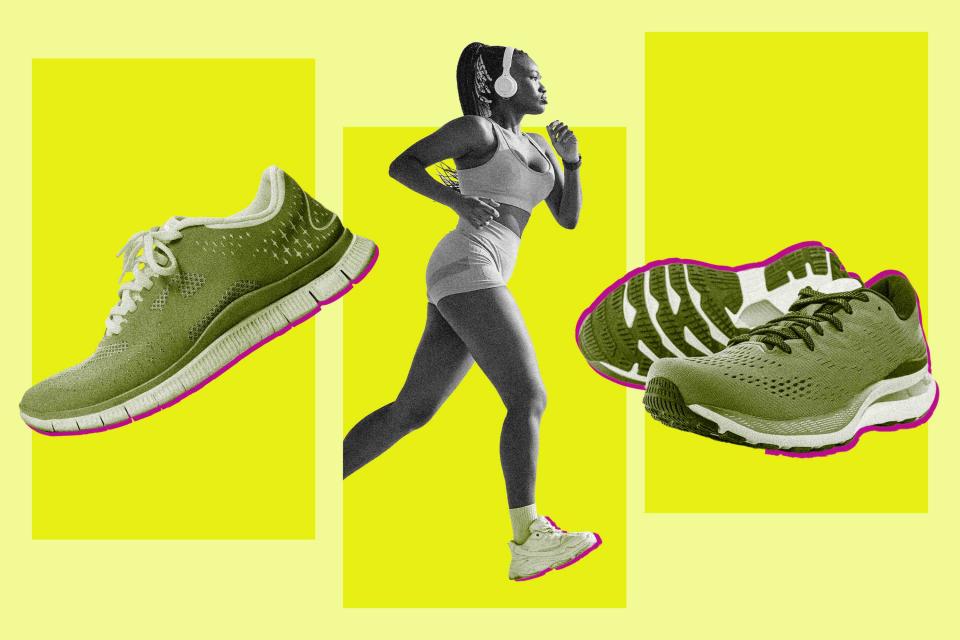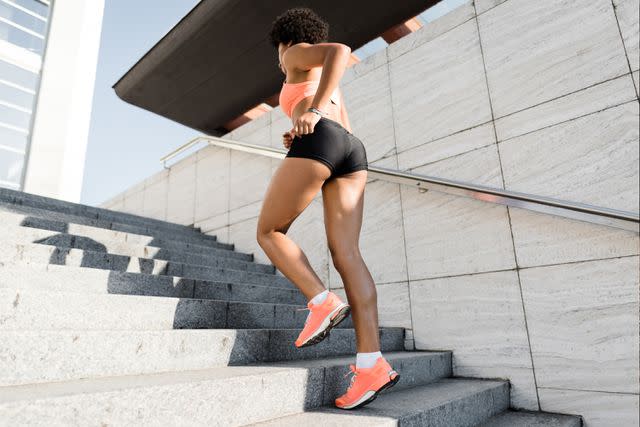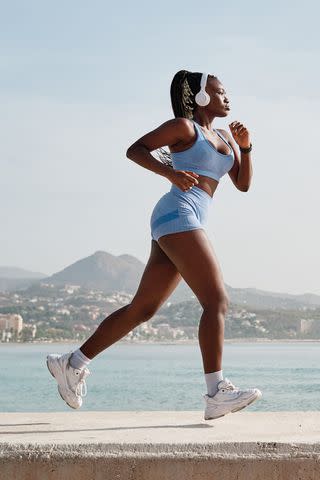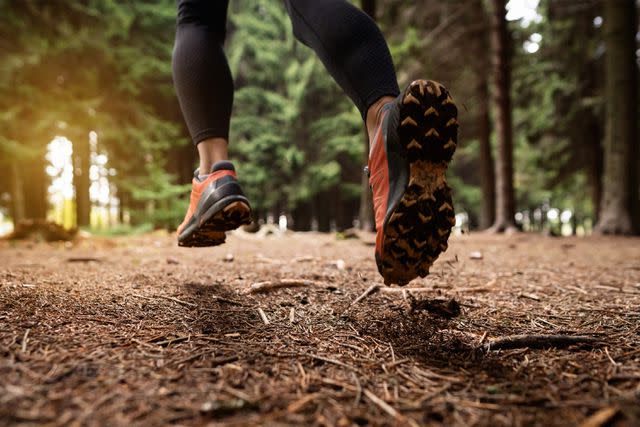Everything You Need to Know About Different Types of Running Shoes
Not every sneaker is right for every foot—or every runner.

Getty Images
Walk into any specialty running store, and you’ll see a wall covered in all kinds of shoes: bright shoes, bold shoes, lightweight minimalist shoes, and ultra-cushioned foot trampolines. But knowing which running shoe one is right for you can be challenging. After all, different types of running shoes serve different purposes and are designed for different kinds of runners. For instance, a pair meant for rocky trails will have distinct features from the pair you would use on the sidewalk. Meanwhile, the biomechanics of how you run might call for a particular amount of stability or cushioning.
Learning what different types of running shoes offer will help you find the right ones for your feet—and improve your performance, too. In fact, one study found that people run most efficiently in the shoes that feel the best.
“What is incredibly important is that you choose a shoe that's comfortable for you,” says Heather Milton, MS, RCEP, CSCS, exercise physiologist supervisor at NYU Langone’s Sports Performance Center.
If you’re not sure where to start looking for your Cinderella-style fit, we broke down everything you need to know about the different types of running shoes. Consider this your first stop to finding the kicks that will serve your running best.
Types of Running Shoes by Stability Level
Running shoes come in three different levels of support: neutral, stability, and motion control. When you’re running, it’s natural (and useful!) to pronate, or have your arch collapse and roll inward as your foot lands. This is one of the ways that your body absorbs shock and propels you to your next step.
But some runners overpronate to the point where it could cause injuries. That's where stability and motion control shoes come in to help keep everything aligned. People with flat feet are more likely to need extra stability, too.
Milton says it comes down to your biomechanics and how your particular feet behave when you’re in motion. Unless you have access to advanced gait analysis, the best way to tell which level of stability is right for you is simply to try out each type, then go with the one that’s most comfortable. Here are the types of running shoe support to consider.

Getty Images
Neutral
The majority of runners are best served by a neutral shoe. These are your standard running shoes without additional stability features. If you only overpronate while running (not while standing still or during an exercise like a single-leg squat), Milton suggests sticking with a neutral shoe but doing exercises to strengthen the foot and ankle muscles.
Stability
A stability shoe is designed to offer additional support in the arch area to a runner who overpronates and needs help to control the angle of their foot. Running coach Tammy Whyte, CPT, who used to work at a running store, points out that shoes achieve this stability in a few ways, like with a medial post or a guide rail. But not all stability shoes offer the same amount of pronation control. You might need to try a few to find the right level for you.
Motion Control
As a more intense version of a stability shoe, motion control shoes are meant for people with rigid flat feet and extreme overpronation. Those who have severe foot problems and need a great deal of support also might benefit from motion control shoes.
Types of Running Shoes by Cushioning
The amount of foam underneath your foot in a running shoe can vary widely, but the “best” amount to have mostly comes down to personal preference. Here are some types of cushioning you will find in running shoes.
Moderate Cushion
This type of cushion is found in your middle-of-the-road, standard running shoe. Most of the time, they will contain an average amount of midsole foam that hits a balance between plush and responsive.
Max Cushion
Many newer runners gravitate toward highly-cushioned shoes that help to soften their landings for a more comfortable ride. Whyte says some experienced runners will even have a chunkier shoe in their rotation for recovery runs when their body is feeling a bit beat up. These shoes also help reduce any kind of additional stress on their body, she says.

Getty Images
Zero Drop
While most running shoes have more cushioning in the heel than the toes, in zero drop shoes your toes and heels sit in the same horizontal plane—no matter how much cushioning there is overall. “In the past, it was proposed that if you took away that heel rise, that would force people to learn how to land on their mid-foot,” says Milton.
However, zero drop shoes change the mechanics of running if you’re used to a typical shoe with 8 millimeters or more of heel-to-toe drop. That shift can put extra stress on your calves and Achilles, so this kind of shoe needs to be transitioned into carefully. Running too much in these shoes before you're used to them could cause injury.
Minimalist
These types of running shoes are not only zero drop but also have little-to-no cushioning. They give you the strength-building benefits of barefoot training while protecting your skin from things like rocks and germs. Just like any other zero-drop shoe, you need to transition into it gradually to keep your body safe and to avoid injury.
Types of Running Shoes for Different Surfaces
While any running shoe can take you down a given running path, one that’s designed for the specific surface you’re on will be the safest and most comfortable option. Here are some types of running shoes that are designed with a specific surface in mind.
Trail Running Shoes
When you hit the trails, you risk slipping on mud or loose dirt. That’s why trail running shoes come with exaggerated lugs on the bottom of the outsole to provide extra traction. They also may have a hard bumper guard on the toe to protect your foot if you accidentally get snagged on a root or rock.
Plus, these shoes usually contain stiffer materials to offer a little extra ankle support. Milton says that, after a previous ankle injury, she would run on the roads in a trail shoe for that extra help.

Getty Images
Unlike a road shoe where the upper might be made of breathable mesh, the fabric in trail shoes will likely offer more solid coverage so dirt and debris cannot slip in. Some trail running shoes are even water-resistant, adds Whyte. That—along with the traction—is one reason why some runners grab trail shoes for runs in the snow.
“It won't help in ice, but for snow, the little bit of grip can help,” says Whyte.
Road Running Shoes
If you’re sticking to paved surfaces like concrete or asphalt when running, a road running shoe will be most comfortable. These shoes are typically lighter than trail shoes, and the materials around the upper are more flexible and breathable.
This is the type of shoe you want to wear if you’re a treadmill devotee, too. Milton points out you may not need as much cushion on a treadmill because it has more give than the sidewalk, but she wouldn’t recommend getting a different shoe just for your treadmill runs. Any road shoe will work just fine.
Hybrid Shoes
Running shoe brands are starting to come out with all-terrain shoes designed to take you from the road to the trail. Their features typically strike a middle ground with slightly more grip than your average road shoe but more flexibility than a heavy trail shoe. Just know that the lugs on the sole will likely be smaller, so these work best on packed dirt trails rather than super technical terrain.
Types of Running Shoes for Various Runs
You don’t need different shoes for every kind of run you do. But if you want a few styles that serve different purposes, these are the options to look into. Here are some common choices for various types of runs.
Daily Trainer
This versatile sneaker is truly the only kind of shoe a beginner runner needs. It’s also what a more advanced runner will reach for during their easy runs and long runs. This running shoe typically comes with a solid amount of cushion, which can make it weigh on the slightly heavier side.

Getty Images
Tempo Shoe
On days you want to pick up the pace, a dedicated speedwork shoe might be lighter weight with less heel-to-toe drop. These usually have less cushion, though some have a nylon plate for an extra kick, says Whyte.
Carbon-Plated Shoe
High-level runners might reach for a carbon-plated shoe on race day to give them an edge. Milton says these running shoes can shave down your time by increasing some of the stiffness in the foot in order to enhance the plyometric effect. However, that benefit isn't as impactful for slower runners, according to one study in the International Journal of Exercise Science. Just be sure to run in these shoes once or twice before race day to get used to the feeling because they tend to put a different load on your body, says Whyte.
Track Spikes
These running shoes are designed for serious track and field athletes. Even if you do intervals on the track regularly as an everyday recreational runner, you don’t need spikes—a light tempo shoe will do the trick. But, if you regularly compete in track and field events, you may benefit from a pair of spikes.
Bottom Line
There are a lot of different types of running shoes out there, and it can be easy to get lost in a sea of technical jargon. But remember: Listen to your feet.
“If it's not comfortable in the store or when you put it on and you go for your first run, it's not the right shoe for you,” says Whyte. You’ll know you’ve found a good pair when you don’t have to think about them at all.
For more Shape news, make sure to sign up for our newsletter!
Read the original article on Shape.

